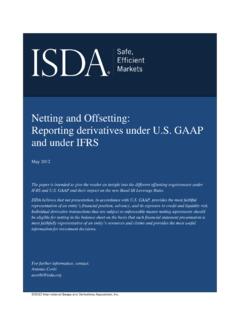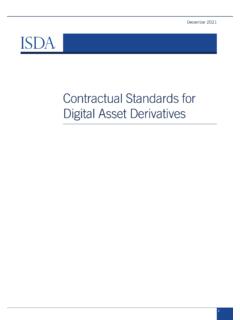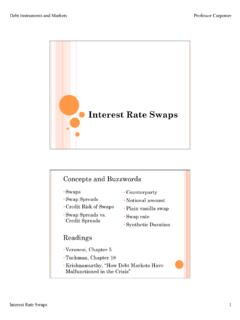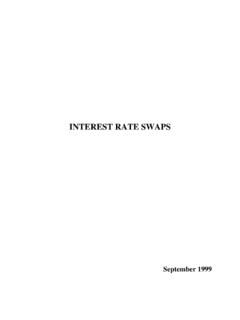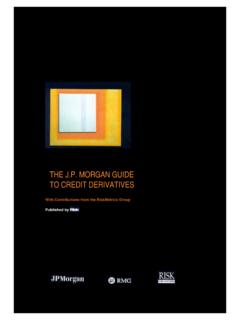Transcription of Interest Rate Swaps Compression: A Progress Report
1 Interest Rate Swaps Compression: A Progress Report ISDA Study, February 2012 Summary This paper describes a risk reduction practice, portfolio compression (compression), which is conducted in the Interest rate swap (IRS) market. Compression enables swap dealers with substantial two-way (pay and receive) swap activity to terminate substantial amounts of swap contracts before they expire by their terms. The benefits of compression include reductions in counterparty credit exposure, operational risk and cost, as well as lower legal and administrative expenses in the event of a default of any participating dealer. Importantly, since contracts are actually eliminated, under some regimes capital costs can be reduced.
2 Together with expanded clearing of IRS, compression produces tremendous reduction of risk in the derivatives marketplace. Compression was introduced to the IRS market in 2003 by TriOptima. Through year-end 2011, participating institutions have eliminated $164 trillion of notional principal outstanding with $56 trillion compressed in 2011 alone. Much of the recent Progress has been the result of collaboration between TriOptima and Ltd. s swap clearing service, SwapClear. We estimate that without compression, the size of the IRS market would be approximately 30% larger. While results have been very positive, challenges remain to improve the scope of compression. Meeting these challenges could result in a marked increase in compression, and might very well enable the derivatives market to shrink in terms of notional outstanding even as annual activity increases.
3 In this paper, we will first set out an overview of the compression process, followed by a series of metrics that evidence the significant Progress achieved to date. We will then highlight the challenges that need to be met to increase compression by a significant amount. We will describe the approaches of four major dealers to maximize the benefits of compression and how adoption of best practices is essential. We will then provide an estimate of what is possible in terms of potential notional that might be compressed. Finally, after a conclusion, an appendix will contain a simple example of the principles behind compression. 2 Interest Rate Swaps Compression: A Progress Report February 2012 Overview of the Compression Process In compression, participating dealers are able to eliminate trades among themselves where the risks of those trades offset one another according to the parameters agreed by each participant.
4 The first step is to get as many dealers as possible to participate. Each dealer is able to specify its tolerances to changes in its portfolio as a result of compression. This is an important step. Dealers specify how much change in Interest rate risk they will accept and across what tenor periods. These tenor periods are called buckets and may be in three-month, six-month or other increments of time out to 50 years. In addition to numerous Interest rate risk parameters, dealers are also able to specify rate reset, cash flow and counterparty risk limits. TriOptima does not require dealers to compromise their risk management practices. While each dealer specifies unique tolerances, similar and permissive tolerances across dealers will increase the effectiveness of compression.
5 Compressions are executed in what are called cycles in a single currency at a time. TriOptima schedules a cycle for a currency with a group of dealers. Each participating dealer submits transactions that it has identified as eligible for compression, based upon an analysis of its swap portfolio in the currency. Each dealer also specifies the tolerances it is willing to accept. TriOptima then uses its compression algorithm to produce an unwind proposal that respects all the tolerance limits specified by each participating dealer. In IRS cycles, unwind proposals identify trades that will be completely or partially terminated to produce the compression results. The transactions are terminated only after all participating dealers have accepted the unwind proposal.
6 After the cycle, each dealer s remaining portfolio has the same market risk ( Interest rate risk) profile as at the start (adjusted for the changes permitted in the tolerance setting phase) and the counterparty risk profile is changed in accordance with the tolerances set by each dealer at the start of the cycle. Reducing and leveling counterparty exposures is a frequent result of compression cycles. Compression Metrics: Progress to Date Globally, over 150 institutions have participated in various compression cycles in a remarkable 25 currencies since the introduction of triReduce in 2003. In 2008, TriOptima began working with SwapClear and its members to compress cleared Swaps . Since a significant inventory of IRS had built up in SwapClear over the years and it was a closed, or nearly closed system, all the risk was contained within its members.
7 Compression in SwapClear reached $89 trillion by the end of 2011. In total, $164 trillion of IRS notional has been eliminated as of the close of 2011. Compression cycles in euro, Yen and USD through February 10, 2012 have reduced notionals in SwapClear by another $ trillion. Much of the Progress occurred in the last year or two. Compression cycles at SwapClear now include four currencies: USD, euro, Sterling and Yen. Twenty-one dealers have actively participated in cycles and an additional eight have agreed to participate going forward. In all, these dealers represent 29 of SwapClear s 62 members. Through this process, more than 950,000 transactions have been completely terminated. 3 Interest Rate Swaps Compression: A Progress Report February 2012 The table below outlines the effects of compression on the aggregate amount of IRS in the marketplace, using BIS June 2011 The first part of the table is labeled Gross Analysis and makes no adjustment for the double-counting of cleared IRS.
8 As can be seen, if compression had not occurred, the notional amount of IRS would be $572 trillion or 29% higher than the latest BIS data of $442 trillion. The lower part of the table is labeled Adjusted Analysis and it reduces the size of the market and the amount of compression to eliminate the double-count resulting from clearing2. The adjusted BIS IRS market is $293 trillion. If not for compression, the adjusted market would have been $393 trillion, or 34% higher. This data does not reflect the additional Progress in the second half of 2011 because it will be several months before the BIS releases data for year-end 2011. Effects of Compression ($ trillions) as of June 30, 2011 Gross Analysis Aggregate IRS outstanding* 442 Aggregate IRS compression 130 Pro forma IRS 572 +29% Adjusted Analysis Aggregate IRS outstanding* 442 Cleared swap adjustment (149) one-half of SwapClear portfolio Adjusted IRS outstanding 293 Adjusted compression 100 reduces compression by $30 trillion Pro forma adjusted IRS 393 +34% * BIS Survey, June 2011 In many ways, compression works because the risk inherent in large swap portfolios can be relatively modest.
9 In fact, over $100 trillion of Swaps have been terminated through compression without significantly changing the risk of the participants market risk portfolios. Active participants fully realize it is exposure to outright Interest rate risk, to curve risk and to spread risk that is most important to risk management, rather than the outstanding notional size of the market. Nonetheless, through compression, it is possible to eliminate the equivalent of trillions of dollars of notional through a small investment of time and resources and a modest change in risk management organization. We strongly believe this small investment represents extremely good value for the industry. Compression Challenges The figures in the previous section are impressive.
10 However, there is scope for much greater success both in the continued compression of bilateral Swaps as well in compression of the growing volumes of cleared IRS Swaps between dealers. There are three main challenges to overcome. These are: 1 The table assumes that all compressed IRS would otherwise be outstanding and, as a result, it overstates the size of the market somewhat. 2 Compared with bilateral execution, clearing double-counts the amount of outstanding Swaps , as both parties to each cleared transaction book a swap with the clearing house. 4 Interest Rate Swaps Compression: A Progress Report February 2012 Numerous Booking Desks.
